You could say that we are huge fans of intensive gardening techniques. We use intensive gardening techniques in practically every aspect of our gardening efforts!
Many people’s introduction to gardening itself comes by way of a technique called “square foot gardening.” It’s an intensive planting technique that promises to allow a huge amount of food in a very small space.
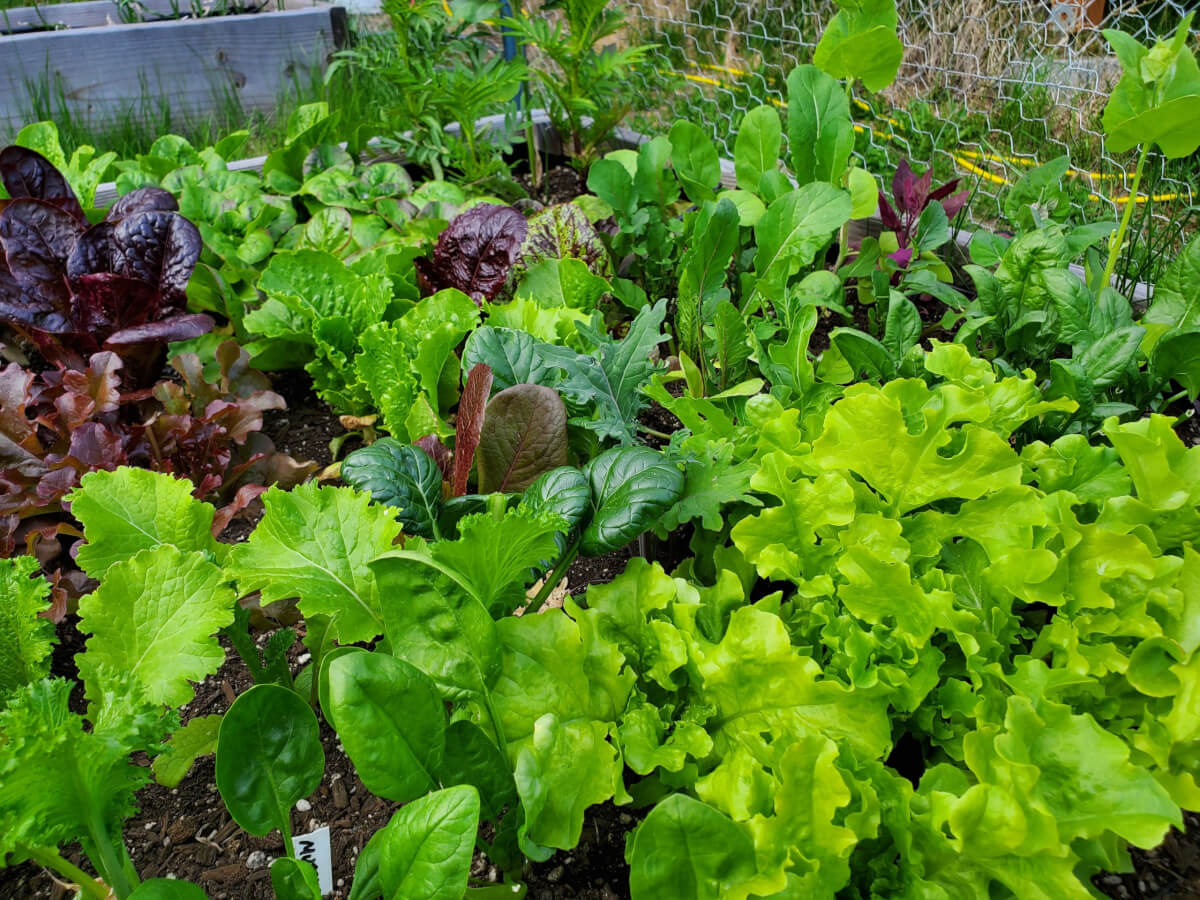
As experienced practitioners of the technique, we want to share our depth of knowledge about the subject. It is and isn’t the growing mecca that everyone hopes for.
What Is Square Foot Gardening And Intensive Planting?
If you think of most commercial food growing operations, the vision of rows upon rows of a given fruit or vegetable come to mind. These methods scale well to the commercial grower, allowing for mechanization and other efficiencies.
Those techniques are quite wasteful when it comes to space utilization at the home-garden scale, though.
Intensive gardening is a generic term used to describe methods of maximizing the garden space you use to grow your plants.
Square foot gardening, an intensive gardening technique, was popularized by Mel Bartholomew in his book Square Foot Gardening. At the simplest form, it’s the practice of dividing a raised bed into square feet.
From there, it involves planting things 1, 2, 4, 9 or 16 per square foot, depending on the plant’s spacing needs.
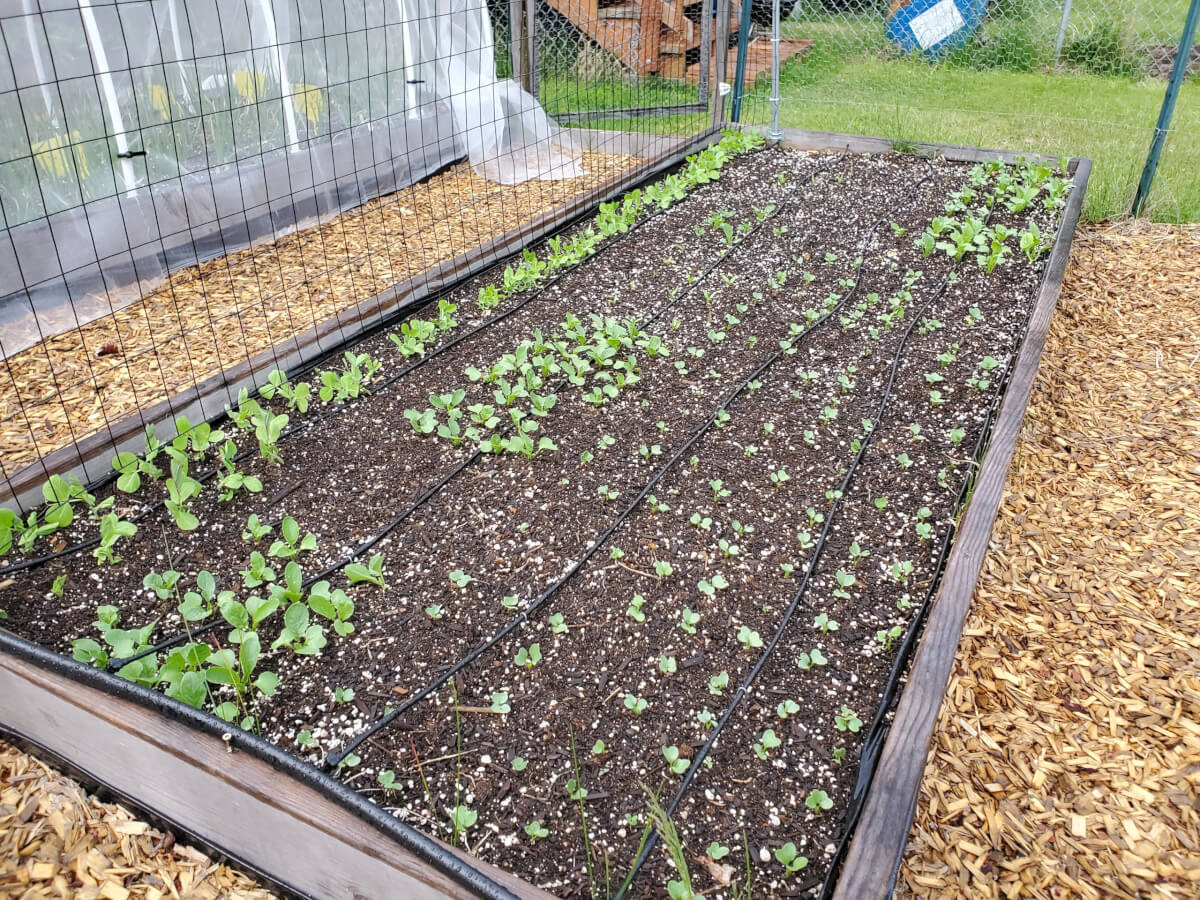
This is an early year photo of our “from seed” garden, mostly root vegetables. It borrows heavily from the square foot gardening method.
Conceptually, any given plant needs a certain amount of space to grow. If the plant is expected to get six inches wide, it needs three inches of space in every direction.
So, instead of thinking in terms of rows, plant separation is determined by the plant and the space it needs in all directions. A raised bed can be used to maximum extent this way.
Falling Into The Square Foot Gardening Trap
When I first read Mel’s book on Square Foot Gardening, I remember thinking how it was going to revolutionize everything! There were no other needed gardening methods!
I read every page of the book and by the following spring, had transformed one of my beds into a square foot gardening trial. I followed the directions to a T, complete with “Mel’s Mix” and compost from five different sources!
Ignorance being what it is, I assumed everything in the book was true and possible.
That was one of the most chaotic and unsuccessful gardens in memory.
Onions growing next to tomatoes, broccoli shading out carrots. Kohlrabi competing with kale, radish succumbing to zucchini.
Many things didn’t produce, or produced very little.
Turns out, it really isn’t possible to grow everything together in a small amount of space.
Plants aren’t these perfect little replicants that fit into neat little boxes. No, they have life and grow all sorts of which ways, something not easily contained into a perfectly spaced method.
There’s a lot more finesse required and that’s what this post is leading up to.
Taking The Good, Leaving The Bad From Square Foot Gardening
After that initial year that resulted in failure, I gave a much more critical eye to the general square foot gardening technique overall.
In hindsight, that’s where I branched off from being a “square foot gardener” to one more interested in general intensive gardening. In essence, finding the “right way” to do it.
Mel’s book and techniques aren’t all bad. The book is well worth reading, full of great knowledge that forms the literal foundation of intensive gardening.
His book introduced me to concepts like soil building, the value of composting and countless other gardening expertise I’ve since integrated into practice.
The problem is that you can’t get around large plants, medium plants and small plants all co-existing together and not creating problems for each other.
Some plants are quoted as needing “one” square foot in the square foot gardening method. In truth, they need 18 or maybe even 24 inches. We cover all of the major changes we made to square foot gardening in this video:
Not only can large plants affect smaller plants, but many plants will not grow or produce particularly well when they are too crowded.
Radicchio comes to mind. A plant I struggled with for over a decade. It wasn’t until I gave it room that it actually did what radicchio is supposed to do!
It wasn’t that the technique did not work, it’s just that you just have to put a lot more thought into a given plan. The mecca of growing everything in a small space wasn’t practical, at all.
We also diverge heavily on the nutrition aspects of square foot gardening. Whereas the original technique requires heavy compost, we generally infuse fertilizers into our soils. See this video for how we prepare our beds for intensive planting:
The rest of this article is going to discuss the various cases where we’ve modified and improved upon the general square foot gardening and moved more into general intensive gardening.
A More Sane Approach To Intensive Gardening
If we could sum up what we’ve learned about intensive gardening, it’s to group plants by their general size.
We’ve learned to think of plants in terms of small, medium and large. When these plants co-exist with one another, they should be planted near and among other plants of similar size.
Small plants should be near other small plants. Medium plants near medium. And large? Well, maybe there’s a better way.
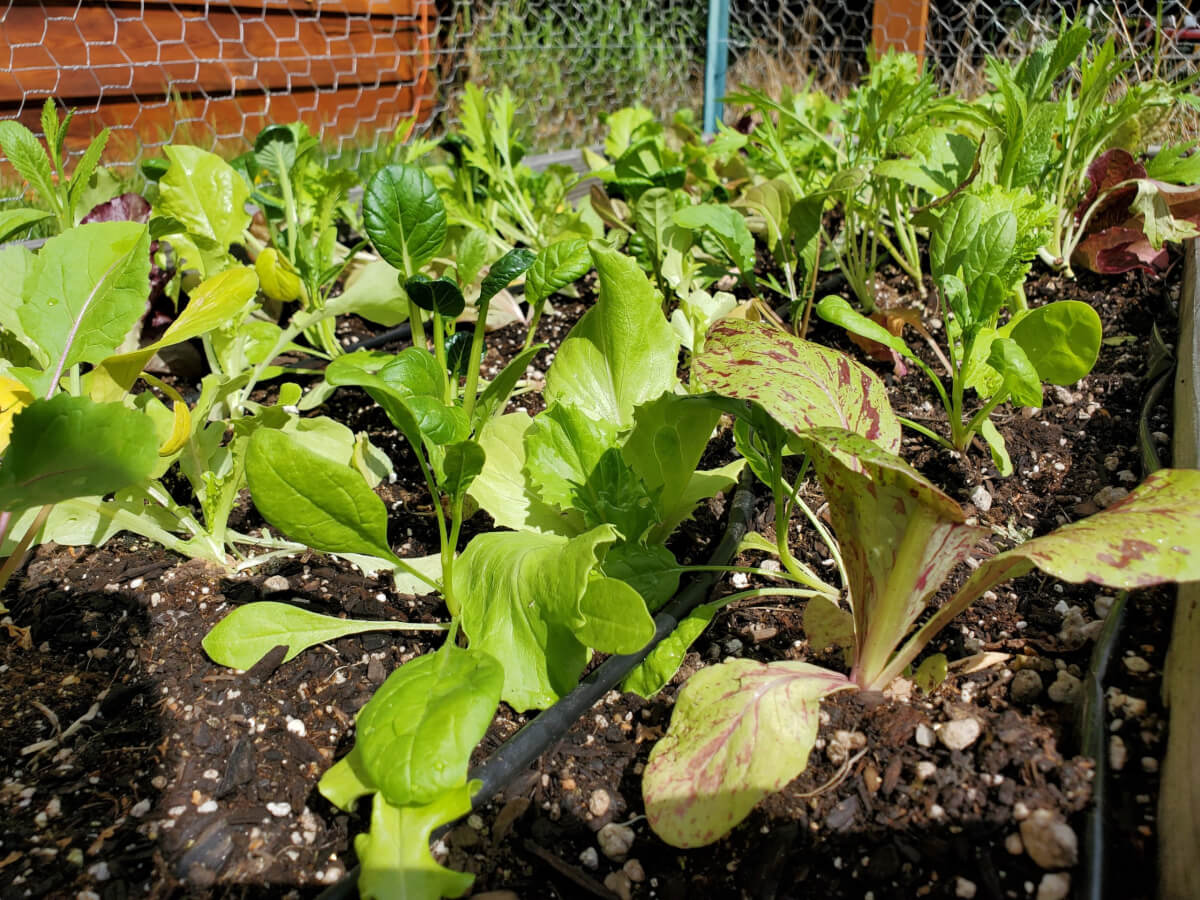
Likewise, some plants grow very differently from one another. There’s no arguing the difference between a rooted carrot and a tomato plant that can grow 10 feet in the air!
We’ve generally found it good to plant root vegetables with other root vegetables. Leafy plants among leafy plants. Vining plants, like cucumbers and tomatoes, can share space with other plants. But, you have to take care to offer them a trellis to grow tall and not shade out other plants!
A General Categorization Of Plant Size & Characteristics
The above information doesn’t really help a new gardener unless you have a general understanding of the size and growing characteristics of most plants.
If you’re still learning the ropes of how various vegetables grow, this is a basic run down of the common garden plants by size and in general, how they grow.
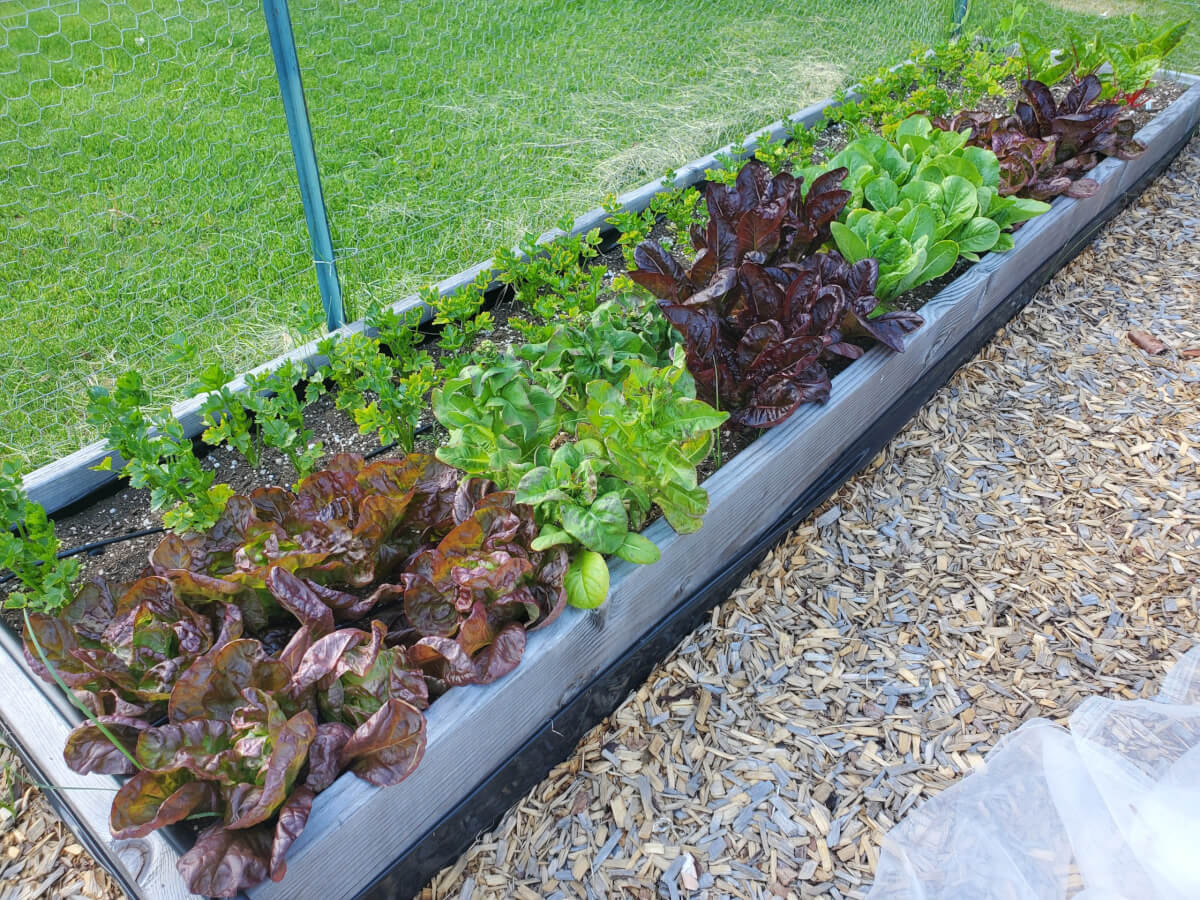
If you’re new to intensive gardening, some of our notes will help you understand plants that work very well in intensive planting, versus others where you might consider other growing methods.
| Vegetable: | Growing Style: | Growing Size: | Notes: |
|---|---|---|---|
| Cucumber | Vining | Small | Good for intensive planting, but requires height/trellis! |
| Garlic | Bulb/stalk | Small | Very good for intensive planting |
| Onions | Bulb/stalk | Small | Very good for intensive planting |
| Shallot | Bulb/stalk | Small | Very good for intensive planting |
| Leek | Bulb/stalk | Small | Very good for intensive planting. |
| Arugula | Leafy | Small | Very good for intensive planting. |
| Lettuce, Leaf | Leafy | Small | Very good for intensive planting. |
| Mustard Greens | Leafy | Small | Very good for intensive planting. |
| Bok Choy | Leafy | Small | Very good for intensive planting. |
| Spinach | Leafy | Small | Very good for intensive planting. |
| Chard, Swiss | Leafy | Small | Very good for intensive planting. |
| Beets | Root with leaf | Small | Very good for intensive planting. |
| Carrot | Root with leaf | Small | Very good for intensive planting. |
| Parsnip | Root with leaf | Small | Very good for intensive planting. |
| Peas | Vining | Small | Very good for intensive planting, but requires height/trellis! |
| Radish | Root with leaf | Small | Very good for intensive planting. |
| Herbs | Generally leafy | Medium | Good for intensive planting. Some herbs are less ideal, like dill/fennel. |
| Celery/celeriac | Leafy/stalk | Medium | Very good for intensive planting. |
| Eggplant | Leafy/some vining | Medium | Needs 18" spacing! |
| Peppers | Leafy | Medium | Needs 12-18" spacing! |
| Radicchio | Leafy | Medium | Needs 18" spacing! |
| Lettuce, Head | Leafy | Medium | Good for intensive planting. |
| Basil | Leafy | Medium | Good for intensive planting. |
| Chinese Cabbage | Leafy | Medium | Very good for intensive planting. |
| Rutabaga | Root with leaf | Medium | Very good for intensive planting, larger than most root veggies. |
| Corn | Leafy/stalk | Large (tall, not wide) | Good for intensive planting. |
| Squash, Winter | Vining/spreader | Large | Not good for intensive planting. Needs 36"+ spacing. |
| Artichoke/Cardoon | Leafy | Large | Needs 18-24" spacing! |
| Brussels Sprouts | Leafy/stalk | Large | Needs 18-24" spacing! |
| Collards | Leafy | Large | Needs 18-24" spacing! |
| Ground Cherries | Leafy | Large | Needs 18-24" spacing! |
| Huckleberry, Garden | Leafy | Large | Needs 18-24" spacing! |
| Tomatoes | Leafy/vining | Large | Needs 18" spacing and height. |
| Tomatillo | Leafy/vining | Large | Needs 18" spacing and height. |
| Broccoli | Leafy | Large | Needs 18" spacing. |
| Kale | Leafy | Large | Needs 18" spacing. |
| Cauliflower | Leafy | Large | Needs 18" spacing. |
| Kohlrabi | Leafy | Large | Needs 18" spacing. |
| Cabbage | Leafy | Large | Needs 18-24" spacing. |
| Squash, Summer | Vining/spreader | Large | Needs 36" spacing. |
| Potatoes | Root with leaf | Large | Good for intensive planting. |
Again, when we plant these intensively, we primarily want to consider their size more than any other charcteristic when interplanting with other plants.
The Reality of Large Plant Spacing
There are just certain plants that are going to grow larger than others. If you put these in and around smaller plants, they will eventually shade them out and cause problems in your square foot garden.
In our humble opinion, these plants are poor candidates for square foot gardening in general.

We almost exclusively grow our large vegetables either in-ground or in containers. This allows us to offer them the spacing they really need!
In fact, growing these larger plants in raised beds is a poor proposition. Their size demands a lot of soil space and since soil costs in raised beds are typically high, these are good candidates for other methods.
That’s not to say that large plants can’t be planted intensively, though!
We discuss extensively how we handle many of our larger plants in our “core techniques” guide in more depth, but we’ll touch on it here.
Larger plants are best left to either container gardening or in-ground gardens.
In both our container gardens and in-ground gardens, our large plants are still planted intesively. Instead of “square foot gardening,” we opted to space our plants at 18″ from one another.
For example, our outdoor container gardens use 18 inch spacing:

Our greenhouse also uses 18 inch spacing, a common spacing requirement for everything we grow in here:
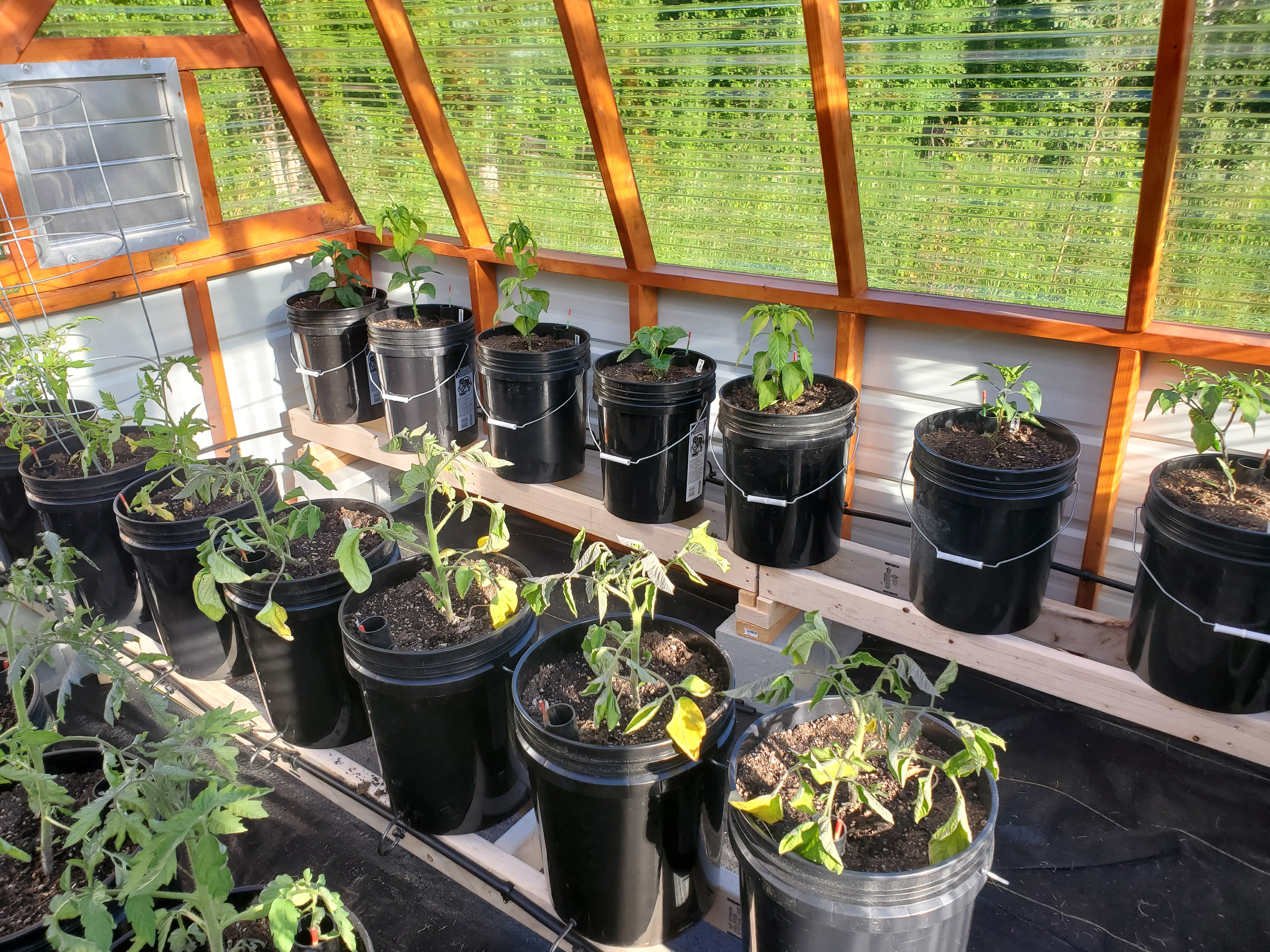
Most of our large plants are planted 24 inches from each other in our in-ground garden! In this case, we chose 24 inches because it was flexible enough for any large plant we’d want to grow!
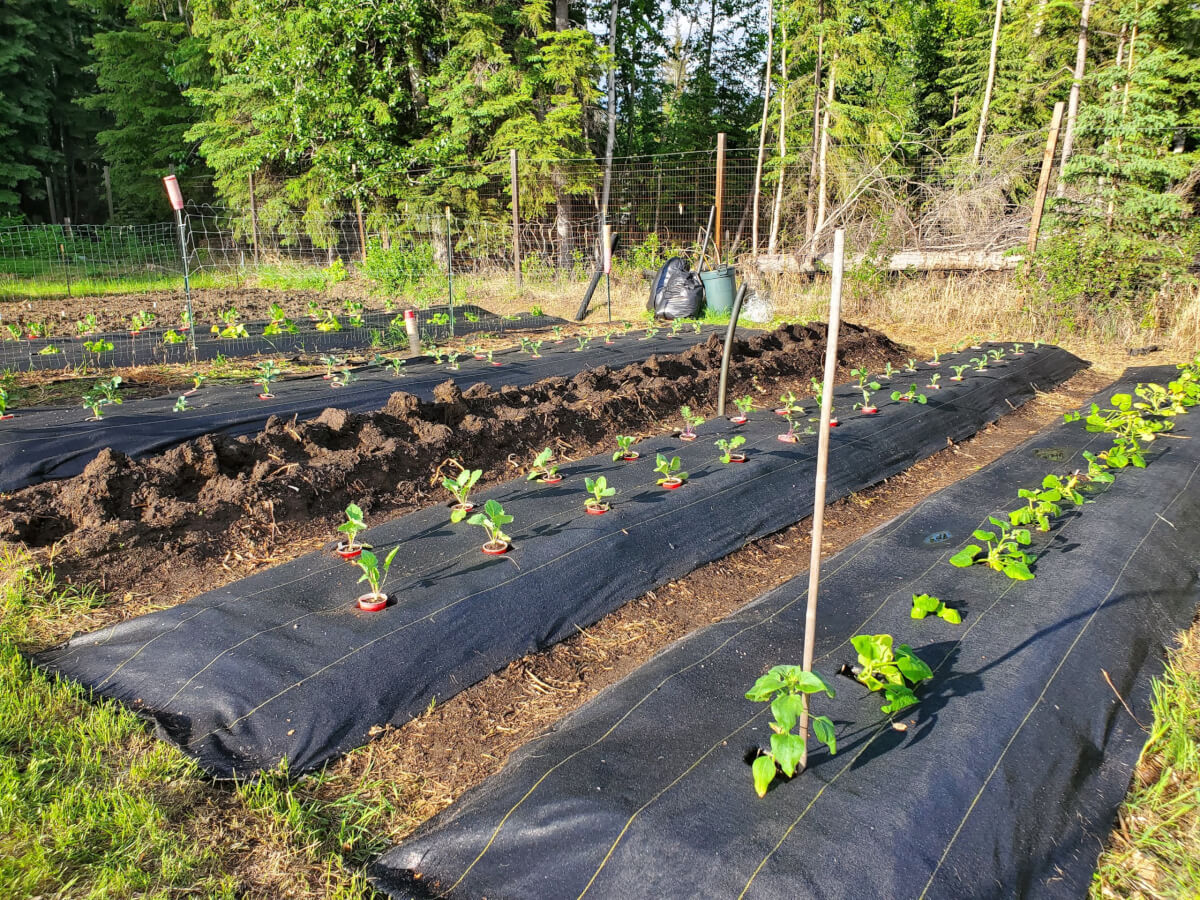
And for our squash? Also intensively planted. Just with 36 inch spacing! Squash need a lot of berth!

Even though we grow our herbs in containers, we still plant them intensively! We often plant 4 or 5 herbs per bucket, which is almost a square foot.
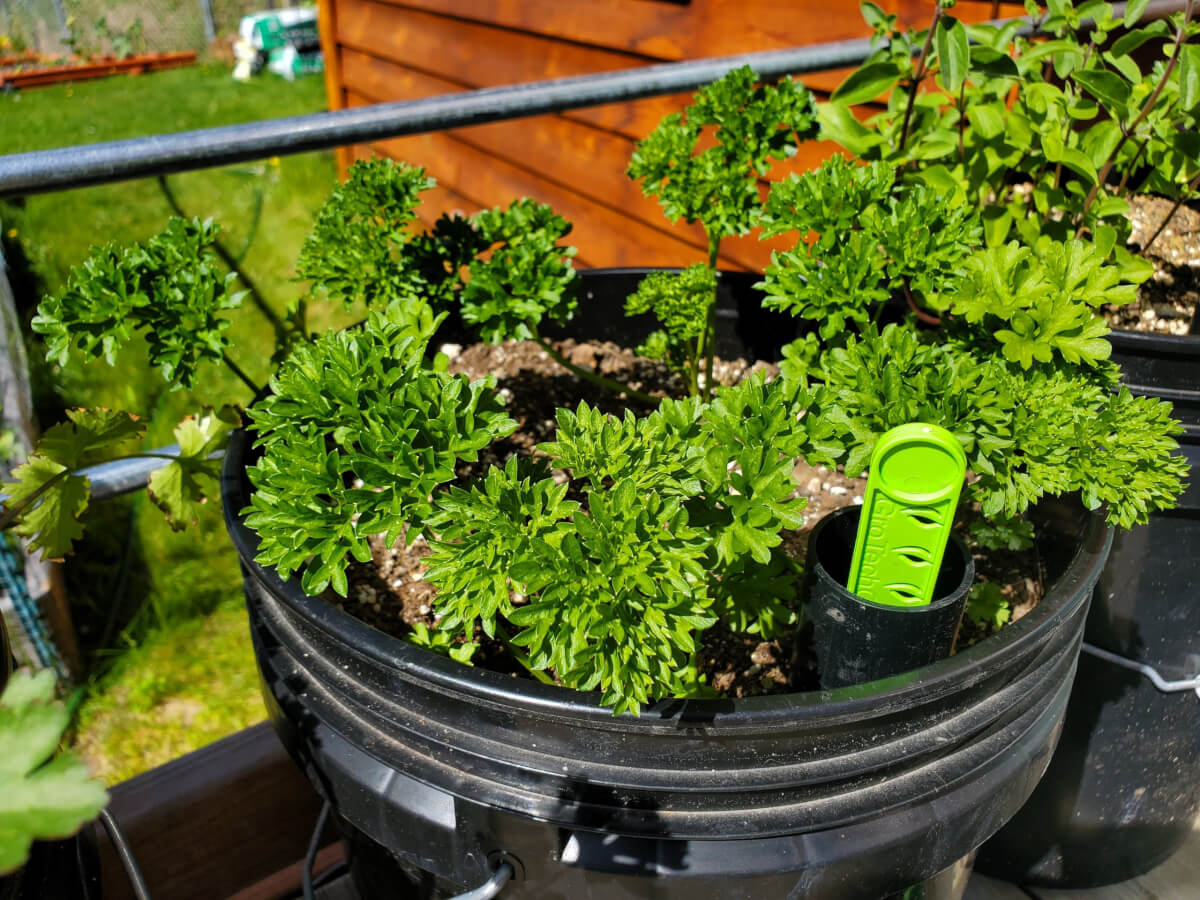
Pretty much all the plants we grow are planted intensively, maximizing our growing space and soil utilization. In fact, we chose the wide-raised row growing technique in our in-ground gardens for exactly this purpose!
The point is that we utilize different growing techniques to execute on intensive gardening more effectively.
If you note in the above pictures, we’re able to get two rows of plants in a single wide raised row. This allows us to see every bit of every plant, plus get the most out of the space we have.
Our Modifications To SFG Plant Spacing
This section will provide a full list of all of our general modifications to the square foot gardening spacing guidelines.
In some cases, you’ll see that we generally agree with the original recommendations. In other cases, you’ll see extreme divergence. Our difference of opinion is based on experience.
We’d also mention that some of our spacing is modified due to our cold climate.
For example, herbs can certainly grow for six months or more, but we can’t do that here with a three month growing season. So, we “up” our plant count to increase density and final harvest levels.
| Plant: | Original Plants Per Square Foot | Frosty Garden's Plants Per Square Foot |
|---|---|---|
| Arugula | 4 | 4 |
| Asian Greens | 4 | 4 |
| Basil | 2-4 | 2 |
| Beans | 4-9 | 9 |
| Beets | 9 | 9 |
| Bok Choy | 9 | 9 |
| Broccoli | 1 | 18-24 inches |
| Brussels sprout | 1 | 18-24 inches |
| Cabbage | 1 | 24 inches |
| Carrots | 9-16 | 16 |
| Cilantro/Coriander | 1 | 4 |
| Corn | 4 | 4 |
| Cucumbers | 2 | 2 |
| Collards | 1 | 18-24 inches |
| Eggplant | 1 | 18 inches |
| Endive | 4 | 4 |
| Fennel | 4 | 4 |
| Garlic | 9 | 9 |
| Green Onion | 16 | 16 |
| Kale | 1 | 18-24 inches |
| Kohlrabi | 4 | 18 inches |
| Leeks | 9 | 9 |
| Lettuce (leaf) | 6 | 9 |
| Lettuce (head) | 4 | 2-4 |
| Melon | 1 | 24 inches |
| Mint | 1-4 | 4 |
| Oregano | 1 | 4 |
| Parsley | 4 | 4 |
| Parsnip | 9 | 9 |
| Peas | 4-9 | 6 (every 2" along trellis) |
| Peppers | 1 | 18 inches |
| Potatoes | 1 | 1 |
| Pumpkins | 1 | 36 inches |
| Radicchio | 2 | 18 inches |
| Radish | 16 | 16 |
| Rhubarb | 1 | 24 inches |
| Rosemary | 1 | 4 |
| Rutabaga | 4 | 4 |
| Sage | 1 | 4 |
| Scallions | 16 | 16 |
| Shallots | 4 | 4 |
| Spinach | 9 | 9 |
| Squash (summer) | 1 | 24-36 inches |
| Squash (winter) | 1 | 36 inches |
| Strawberry | 4 | 1-4 |
| Swiss Chard | 4 | 4 |
| Tarragon | 1 | 1 |
| Tomatoes | 1 | 18-24 inches |
| Turnips | 9 | 9 |
| Thyme | 1 | 4 |
| Onion | 4 | 4 |
| Zucchini | 1 | 24 inches |
Think About The Sun And Plant Shading
Another topic that really isn’t discussed in Mel’s square foot gardening book is the general strategy of how you should go about planting intensively.
You probably know that the sun will largely be towards the south most of the summer. Your garden might get great morning or evening sun.
If you’re planning an intensively planted bed, it’s good to think about how the sun will work with it.
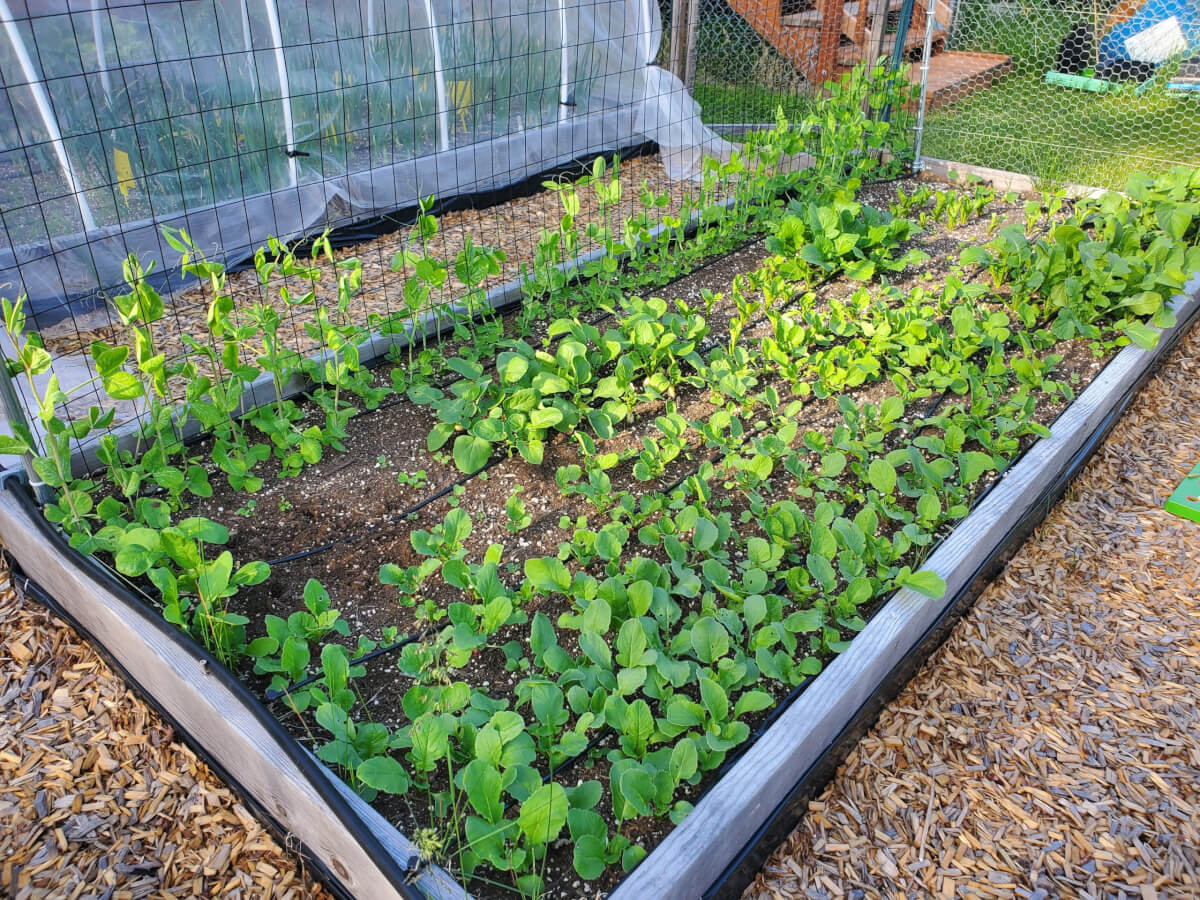
Plants that have less height are planted towards the southern end. Our beds get great evening sun exposure, so we also put larger plants towards the east. A trellis is placed at the most northern point of the bed to grow tall plants.
In general, we try to get our smallest plants towards the southern extents of the bed, with the medium plants towards the north.
This will ensure that larger plants don’t shade smaller plants, which can negatively affect their growth.
In our case, we get better evening sun exposure on our beds, so we also focus larger plants towards the eastern side of the bed, ensuring they won’t shade out other plants from evening sun.
Like Among Like For Intensive Planting
We touched on this above, but we’ll reiterate it here.
Beyond plant size, we have also found value in planting similar growing things near similar things.
For example, one of our beds is almost entirely dedicated to root vegetables. This ensures we can treat the entire bed in a similar way, from fertilization to harvesting.
Another example is combining our allium. We like to have a bed dedicated to onions, leeks, green onions and similarly growing veggies. This also allows us to protect all these allium from garden threats like the onion fly.
We also dedicate a bed for leafy greens. We easily combine head lettuces, leaf lettuces, chards, bok choy and other leafy-type vegetables. They all share similar nutrition needs and growing characteristics.
We can also choose to dedicate a given bed to a particular crop. Sometimes we use our smaller raised beds to produce a particular food that we want a lot of, such as carrots.
The main benefit of this concept is allowing the gardener to specialize fertilization methods. Root veggies highly benefit from potassium and phosphorus. Leafy greens, nitrogen. Allium demand a well balanced approach.
The gardener can then focus particular applications on a per-bed basis, as opposed to having to develop a one-size-fits-all approach.
Utilize Different Size Growing Beds
In Mel’s book, he frequently uses the 4 foot by 4 foot bed as the basis for his methods.
He also teaches that it’s good to not have any bed where you can’t reach plants within two feet of the edge of the bed.
This is great advice, particularly the bit about not having to reach more than 2 feet into a bed. But, we disagree about the 4×4 beds.
We’ve found it useful to have beds of different sizes. When we built our current raised beds, we purposefully used beds of different sizes.
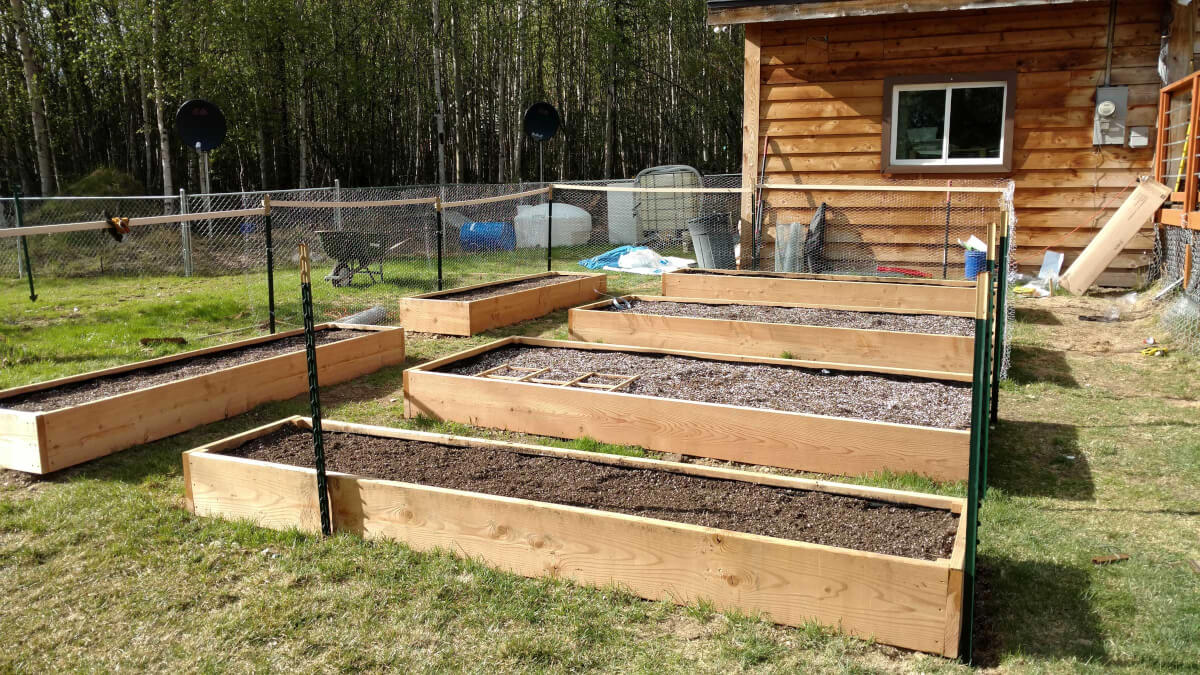
Some are 4×10. Some are 2×10. Others are 2×9. They all follow the “2 foot reach” rule, but width and lengths were more tied to our desired needs.
What we ensured was that we had a full crop rotation plan. We had two of each size bed. This allows us to rotate crops completely between beds each year.
Additionally, the increased size allowed us to meet our production goals. Walkways are wasted space, in our opinion. Put simply, larger beds produce more food.
The different size beds allow us to easily integrate the “like with like” concepts we discussed above, while still reaching our desired production.
Don’t Forget About The Nutrition!
One of the most important and often overlooked aspects of intensive gardening is the importance of soil nutrition.
In Mel’s book, he spends an entire chapter talking about soil health, soil building, compost and how to derive nutrition. This is probably the most important chapter in the book.
We aren’t here to critique people, but most readers miss this part.
We tend to make intensive gardening look “easy” but we’ll tell you that we spend a lot of effort on making sure our plants have what they need to grow well.
When you plant intensively, it puts a lot of demand on the soil’s nutrients. It’s no joke.
We’ve found that we have to supplement heavily with fertilizers to make it work. We’ve tried compost only, even lots and lots of it, and it just often isn’t enough.
Whether you get there through fertilization or intensive composting practices, it makes little difference. It’s the availability of nutrients that matter.
We make a big deal out of nutrition, especially in the subarctic, but it’s important to have regular applications of fertilizer or a very strong soil game to make intensively planted gardens work.
Planting Intensively Makes For More Food In Less Space
We hope that you’ve enjoyed our post about how we integrate square foot gardening and general intensive gardening techniques into our food gardens.
Intensive gardening is an incredible useful method, especially once you get past the limitations of “square foot gardening” in general.
We’ll reiterate that reading Mel’s book is a great introduction to the technique, requirements and general theory. But, we want to temper people’s expectations to some degree. We’ve been there, caught the fever and learned a ton because of it.
As always, if you have something to add or a question rattling around in your noggin’, feel free to slap a comment down below!
That’s All We Wrote!

Having a good time? We have an ever growing list of insightful and helpful subarctic & cold climate gardening articles, waiting out there for you!
- Cold Climate Gardening Basics 👉
- Growing Your Garden From Seed Indoors 👉
- Advanced Cold Climate Gardening Techniques 👉
- Plant Specific Cold Climate Growing Guides 👉
- Subarctic Perennial Food Forests & Foraging 👉
- Indoor Garden Lighting & Grow Rooms 👉
- Greenhouses & Temperature Control 👉
- Harvesting & Food Preservation 👉
- Solving Cold Climate Garden Problems 👉
- 1 Minute Reads On Tons Of Garden Topics 👉
FrostyGarden.com is 100% ad-free and we do not use affiliate links! This resource is voluntarily supported by our readers. (Like YOU!) If we provided you value, would you consider supporting us?

Your content is practical and very helpful!
Thanks for sharing your wisdom 🙂
Thanks for your kind comment, we’re glad we could provide you a helpful resource!
How many cilantro per square foot works best for you?
For cilantro/coriander, we usually do four per square foot. In general, that’s how we treat all herbs. There might be some we’d consider treating differently, but we’ve grown dill, mint and other “large” herbs four per without difficulty. If we were in a warmer climate and longer season (say 5+ months), we’d knock it down to maybe one or two plants as the plants would tend to get much larger. We have a three month growing season, so they can only get so big. (Also, updated the oversight in this article!)
You folks should write a book on this! I would buy it! Especially if it was super detailed and had lots of diagrams based on your measurements and suggestions! SUCH VALUABLE INFORMATION!!!!! THANK YOU!!!
Aww, shucks! Thanks for the kind comment! We have thought about doing a book, so maybe some day! For now, our website is pretty comprehensive and the good thing is we can always add to or edit it!
Great argument to the SFG not always being the best universal fit for all gardens. At the end of the day we have to take any advice with a grain of salt as there are an infinite number of variables that can determine success or failure. I can name one intangible that can’t be purchased, which is motivation. Even with the best advice I quit gardening in my young adult years simply because I didn’t have patience. Now as a father I have more reason to learn and grow (literally) and teach and have my son’s get their hands in the soil!
Thanks for sharing your experience! There are definitely variables with gardening, but skill can be developed. It’s not a perfect substitute for luck (and patience, as you point out), but one can pursue a lot of different avenues given the time, money and motivation to do so. We’ve pursued a scale of trying to “optimize” the time, money and motivation aspects of gardening, which directly speaks to why we use different techniques. SFG is general is “high work, high reward,” but the gist of what we’re saying is that some things can be “low work, high reward” or “low work, low reward” and that’s OK. Good luck teaching your son, it’s great to hear you’re passing on your knowledge!